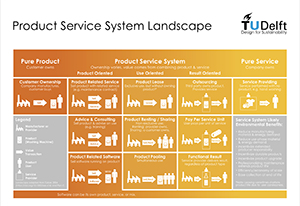circular economy
Exercise
 Time Estimate: 1–3 hours
Time Estimate: 1–3 hours
 Goal: Brainstorm business models to turn your product into a product service system (PSS) for longer lifetime and sharing.
Goal: Brainstorm business models to turn your product into a product service system (PSS) for longer lifetime and sharing.
Step 1: Brainstorm business models to turn your product into a service for lifetime and sharing.
 Time Estimate: 30–60 minutes
Time Estimate: 30–60 minutes
Hold a brainstorm session, based on the PSS landscape table and the Rules of Brainstorming, to generate ideas for changing the business model from a one-time purchase to a service for lifetime and sharing, where your company somehow stays involved in the life cycle of the product.
- You do not need to work off your Whole System Map, but you might find it helpful, especially to see how services could connect other parts of the system.
- Ideally have 5 – 10 ideas for every box in the PSS landscape table. (Ideally 60+ total ideas, but a minimum of 30 ideas.) Have more ideas for the boxes more promising for your product / service.
- For each service idea, list the added value for the customer that that service provides, compared with just purchasing the product. (Does it save the user money, either that one time or in the long run? Does it help the user avoid financial or physical or other risk? Does it provide the user more convenience? Something else?) Don’t write long notes, just a few words like “more convenient” or “lower one-time cost”.
- For each service idea, list the added value for you (the manufacturer and/or service provider), compared with just selling the product.
- If desired, you can also mention if there is value added or lost for other parties in the value chain (e.g., component suppliers losing money from fewer new products produced).
Step 2: Narrow down your brainstorm options to 3–4 winning ideas
 Time Estimate: 5–15 minutes
Time Estimate: 5–15 minutes
Use dot voting, decision matrices, or whatever tools you desire, to narrow down your brainstorm to just 3–4 winning candidates. In addition to judging each idea by material reduction per functional unit of service, use considerations from your design brief’s priorities / metrics to rule out options that don’t meet business criteria such as cost or usability.
Step 3: For each winning idea, sketch and estimate the material reduction of that option.
 Time Estimate: 5–30 minutes
Time Estimate: 5–30 minutes
For each of your winning ideas, draw a quick sketch or storyboard of how the customer uses the product and service. Then estimate each idea’s percent reduction in material use per functional unit of service compared to the original product. For example, if one idea shares the product between two people but only lasts half as long, it does not save any material per functional unit. Something shared between two people and lasting twice as long would save 3/4 the material per functional unit, a huge improvement. Show the math for how you got the estimated percent reduction for each idea.
Step 4: Choose one winning idea and illustrate it.
 Time Estimate: 20–40 minutes
Time Estimate: 20–40 minutes
Choose one winning idea (or combination of ideas), based on the results of the percent reduction in materials intensity, and your other Design Brief priorities. Create a high-quality image of the winning idea, either by hand or digitally, to clearly convey how the idea is different from the current product, and why it’s a compelling design.
Step 5: Document your decision and brainstorm.
 Time Estimate: 30–60 minutes
Time Estimate: 30–60 minutes
Create a PDF with the winning redesign (or the top few), and the reasons why it is the best option.
Checklist for Self-Assessment
To score your success on this exercise, see if you…
- Listed all the new ideas
- Listed each new idea’s value to the customer
- Listed each new idea’s value to you (manufacturer / service provider)
- Listed (or show labeled sketches of) your top 3–4 ideas
- Listed the percent reduction in material use for each of these designs, and show the math.
- Showed the illustration of the winning design.
- Succinctly described the winning design, either as annotations to the illustration or as a standalone sentence or two.
- Briefly described a convincing business case for the final design choice.
All VentureWell Tools for Design and Sustainability content is shareable and usable by CC BY-NC-SA 4.0 license.
